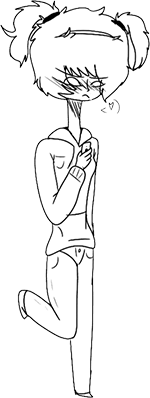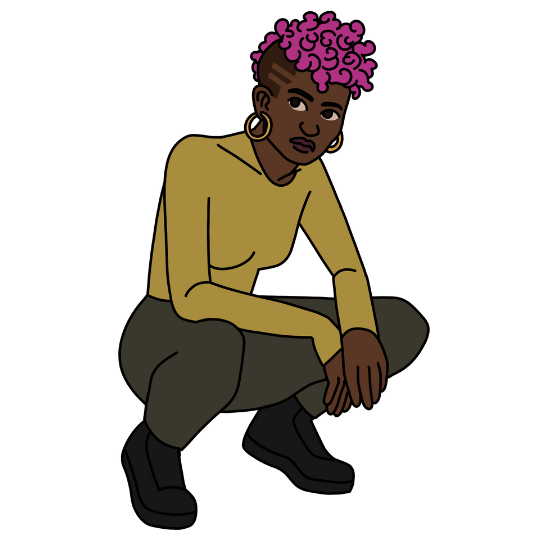An Interview with Rachel Clancy on A Hero’s Guide To Gardening
Posted: 7 Jun 2021We sat down with Rachel Clancy of Tea Creature Studios to discuss their latest title, ‘A Hero’s Guide To Gardening’, which is available now on iOS! A Hero’s Guide To Gardening is an interactive story which teaches young players emotional literacy and covers all sorts of subjects ranging from mental health to LGBTQIA+.
How did you begin the journey of creating your own video game?
My partner (in life and game design!) Aida and I met in 2018 just as I was starting a master’s degree in Independent Games & Playable Experience Design. Hero’s Guide was originally a text adventure game called Get Closer that we created during Global Game Jam in 2019. Aida had the idea to make a game that talked about common misconceptions people have around supporting someone going through depression. My game-making skills at that point were pretty limited to HTML button clicking, but through some thoughtful personal writing and Aida’s gorgeous artwork, Get Closer was received really well for such a simple experience!
What inspired the creation of A Hero’s Guide to Gardening?
We were invited to show Get Closer at the gaming festival EGX Rezzed in April 2019 and while we were there we met members of an organization called Gaming the Mind – a group of mental health professionals interested in the intersection between mental health and games. We got talking about the idea of “emotional literacy” (it means the same thing as emotional intelligence but literacy is used when speaking in an educational context) – and how a game like Get Closer that allows you to role-play conversations centered around feelings could be used as a teaching tool for kids. Aida has a degree in primary school teaching and had been interested in mental health education prior to any game making, so it seemed like a great jumping-off point for a bigger project. In that same year, we saw a funding opportunity in Colin Macdonald’s amazing email newsletter – the Sky Women in Technology scholarship. We used Get Closer as a proof of concept and had the incredible good fortune to be selected for the award of £25,000 to develop the game that became A Hero’s Guide to Gardening. We used the funding to hire developer Destina Connor of Tea Powered Games to bolster our game-making capabilities and the delightful Jefferson Toal as our narrative designer.
You went with an interactive visual story style for A Hero’s Guide to Gardening, what were the reasons to go down that path?
Initially, Hero’s Guide was going to be a 2D RPG-type game – not for any design-led reason, more because I had found a pretty comprehensive 30 part YouTube tutorial on how to make one and thought I could pour our idea into that format. Thankfully this idea was scrapped fairly early on in the project, mainly because as a team that was stronger in art and writing it made more sense to choose a format that played to our strengths rather than including features that didn’t necessarily support the story we were trying to tell. We decided on a format that felt like a playable comic book with character dialogues inspired by what we had tried to do in Get Closer. We looked at interactive narrative games like Florence, or purely dialogue-driven games like 7Days! For inspiration.
What do you want players to take away from the experience of playing A Hero’s Guide to Gardening?
We hope we have created memorable metaphors and illustrations of how to navigate and process the emotions of fear, anger, and sadness. There’s also an overarching message about not being afraid or embarrassed to ask for help or admit when we are struggling. When you’re a kid, you don’t have a long-lived frame of reference for what’s normal. I remember being a kid and feeling ashamed of struggling with school work and feeling embarrassed to tell my parents that I was being bullied. I thought these things were my fault, but if I had spoken up, the adults in my life could have helped take that shame away and helped me come to a solution. To that end, we’re also in the process of creating resources for parents and teachers that use the events of the game as a jumping-off point for further discussions about emotions and mental health.
A Hero’s Guide to Gardening touches many different subjects from representation, love, and mental health, what was your motivation for this?
In a Hero’s Guide to Gardening, the focus of the narrative is on the mental health message, but we do reference gender identity and family relationships as Noomi gets to know the other characters. Ranger Seta is Noomi’s camp counselor and is a non-binary character. When they first meet, Seta tells Noomi their pronouns (they/them) and Noomi tells them hers (she/her). Later when we see Seta’s clipboard up close, we see they have annotated the names of the gardeners in their department with their pronouns as well. It’s a detail that doesn’t change the course of the story but our intention is to make interactions like these a normal part of everyday life. We also make some decisions about the makeup of the families of the campers. For example, Noomi’s relationship with her guardian Astrid is left open to interpretation because we liked the idea that she could be read as fostered or adopted, and we can see in the family portraits in their home that Astrid has a female partner.
If you could give one piece of advice to an aspiring developer that wants to create their first game, what would you tell them?
Global Game Jam really got the ball rolling for us. I think for independent game makers it can be really hard to dedicate time to a passion project outside of work, but hackathons and game jams are a great way to generate a prototype in a quick and focused environment. If you’re a solo developer you might find like-minded teammates that could become future collaborators. Game making is especially tough when you’re on your own because it encompasses so many different disciplines, so meeting other designers and artists can connect you to a network of people who you can bounce ideas off of and ask for advice. Bonus piece of advice – GET ORGANISED BEFORE YOU GET STARTED! I have ADHD and am basically allergic to spreadsheets but I wish I had done more upfront to organize and track the development process – for my sake and for everyone else who worked on this project!
Do you have any plans for future projects in the pipeline?
Right now we are focused on creating extra educational content based on the events and characters of the game (which you can find on our website or our social accounts). Next on the to-do list is a card game that tackles relationship education that I’m currently hashing out with the lovely illustrator and writer Katy Edelsten. We were chatting about the limitations of sex education in schools, and realized that there is so much to learn and understand about how relationships (whether they are casual or committed) work, and what’s safe and what’s respectful that needs to happen before these very practical conversations about how not to get pregnant and how condoms work! Right now though I’m taking a bit of a break and I’m looking forward to spending some time with a soldering iron repairing some of my hardware games that have fallen into disrepair since my MA in 2019! And playing some games, I haven’t had enough time to do that as much as I’d like either!
Tea Creature Studios (@teacreaturestudios) • Instagram photos and videos
Tea Creature Studios Twitter (@TeaCreatures)
A Hero’s Guide To Gardening by Clancy on itch.io
A Hero’s Guide To Gardening on the App Store

